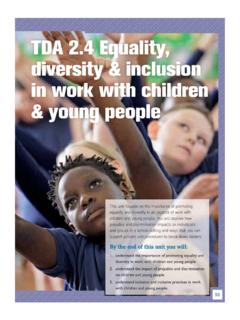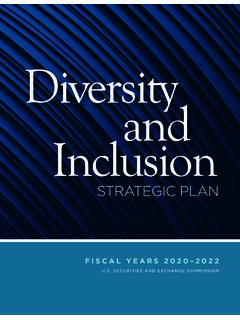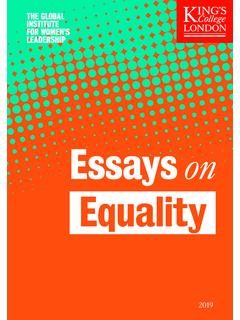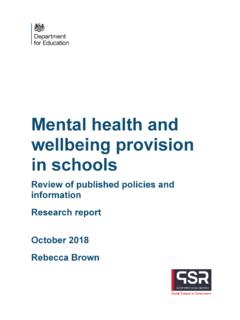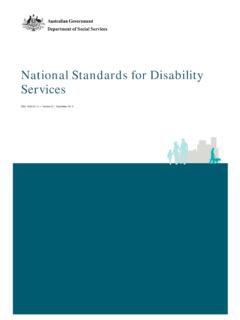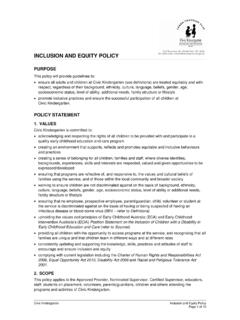Transcription of Chapter I - United Nations
1 17A. The concept of social inclusion Enshrined in the 2030 Agenda is the principle that every person should reap the benefits of prosperity and enjoy minimum standards of well-being. This is captured in the 17 Sustainable Development Goals that are aimed at freeing all Nations and people and all segments of society from poverty and hunger and to ensure, among other things, healthy lives and access to education, modern energy and information. Recognizing that these goals are difficult to achieve without making institutions work for those who are deepest in poverty and most vulnerable, the Agenda embraces broad targets aimed at promoting the rule of law, ensuring equal access to justice and broadly fostering inclusive and participatory decision-making.
2 These goals and targets, when effectively translated into action and properly benchmarked, represent essential elements of social inclusion processes. However, social inclusion encompasses a broader set of concerns than those reflected in the Sustainable Development Goals. No single global, goal-setting agenda can adequately address the multiple dimensions of Key messages Social exclusion is a multidimensional phenomenon not limited to material deprivation; poverty is an important dimension of exclusion, albeit only one dimension. Accordingly, social inclusion processes involve more than improving access to economic resources.
3 Social inclusion is defined as the process of improving the terms of participation in society, particularly for people who are disadvantaged, through enhancing opportunities, access to resources, voice and respect for rights. Measuring social exclusion is challenging due to its multidimensional nature and the lack of standard data sources across countries and for all social groups at highest risk of being left behind. Despite limitations, the existing data allow for a meaningful analysis of key aspects of exclusion. The report presents these data while illustrating data gaps. While inclusion is a core aspiration of the 2030 Agenda, conceptual and analytical work on what constitutes inclusion , as well as efforts to improve data availability, are IIdentifying social inclusion and exclusion18 Leaving no one behindexclusion or comprehensively promote inclusion , particularly given the diversity of circumstances around the Chapter presents working definitions of social exclusion and social inclusion and discusses concepts as well as measurement issues.
4 Different places have different histories, cultures and institutions, which shape norms, values and therefore different approaches to social inclusion . It is contended, however, that the goal of achieving a society for all must conform to some general principles, even if the country-specific and evolving nature of social exclusion concerns and approaches to inclusion is Social exclusion Although there is no universally agreed definition or benchmark for social exclusion, lack of participation in society is at the heart of nearly all definitions put forth by scholars, government bodies, non-governmental organizations and others (see box ). Overall, social exclusion describes a state in which individuals are unable to participate fully in economic, social, political and cultural life, as well as the process leading to and sustaining such a state.
5 14 Participation may be hindered when people lack access to material resources, including income, employment, land and housing, or to such services as education and health care essential foundations of well-being that are captured in Agenda 2030. Yet participation is also limited when people cannot exercise their voice or interact with each other, and when their rights and dignity are not accorded equal respect and protection. Thus social exclusion entails not only material deprivation but also lack of agency or control over important decisions as well as feelings of alienation and inferiority. In nearly all countries, to varying degrees, age, sex, disability, race, ethnicity, religion, migration status, socioeconomic status, place of residence, and sexual orientation and gender identity have been grounds for social exclusion over term social exclusion was used for the first time by former French Secretary of State for Social Action, Ren Lenoir (1974)
6 , to refer to the situation of certain groups of people the mentally and the physically handicapped, suicidal people, aged invalids, abused children, drug addicts, delinquents, single parents, multi-problem households, marginal, asocial persons, and other social misfits whom he estimated to comprise one tenth of the population 13 The Programme of Action of the World Summit for Social Development noted that the aim of social integration was to create a society for all in which every individual, each with rights and responsibilities, has an active role to play. See footnote Accordingly, the concept of social exclusion is used throughout the report as a general term to describe lack of participation in or exclusion from economic, political, cultural, civic and/or social life.
7 Lack of participation in political processes, in civic life or in the labour market are construed as aspects of overall social social inclusion and exclusion 19of France and who were considered vulnerable yet outside the realm of social insurance systems of the welfare state. The concept soon took hold in other developed countries; more recently, the European Union dedicated 2010 as the European Year for Combating Poverty and Social Exclusion. Experts have questioned the utility of the social exclusion framework to lower-income, developing countries (Saith, 2001). Where the majority of a population work in informal and insecure employment, lack social protection coverage or do not complete secondary education, standards of normality as benchmarks of inclusion or exclusion are not what are aspired to.
8 Yet, in Sen s (2000) view, the concept and its focus on relational features has led to richer analysis of processes that result in poverty and capability deprivation, many aspects of which are common across regions even at different levels of development. Issues related to the status, segregation and disempowerment of migrants, for instance, affect a growing number of countries developed and developing. Box definitionsSocial exclusion Exclusion consists of dynamic, multi-dimensional processes driven by unequal power relationships interacting across four main dimensions economic, political, social and cul-tural and at different levels including individual, household, group, community, country and global levels.
9 It results in a continuum of inclusion /exclusion characterized by unequal access to resources, capabilities and rights which leads to health inequalities , (Popay and others, 2008, p. 2). Social exclusion is a complex and multi-dimensional process. It involves the lack or de-nial of resources, rights, goods and services, and the inability to participate in the normal relationships and activities, available to the majority of people in a society, whether in eco-nomic, social, cultural or political arenas. It affects both the quality of life of individuals and the equity and cohesion of society as a whole (Levitas and others, 2007, p. 9). Social exclusion is what can happen when people or areas suffer from a combination of linked problems such as unemployment, poor skills, low incomes, poor housing, high crime, poor health and family breakdown ( United Kingdom Office of the Deputy Prime Minister, 2004, p.)
10 2). Social inclusion The process of improving the terms for individuals and groups to take part in society and The process of improving the ability, opportunity, and dignity of people, disadvantaged on the basis of their identity, to take part in society (World Bank, 2013, pp. 3-4). Social inclusion is a process which ensures that those at risk of poverty and social exclu-sion gain the opportunities and resources necessary to participate fully in economic, social, political and cultural life and to enjoy a standard of living that is considered normal in the society in which they live. It ensures that they have greater participation in decision making which affects their lives and access to their fundamental rights (Commission of the Euro-pean Communities, 2003, p.










